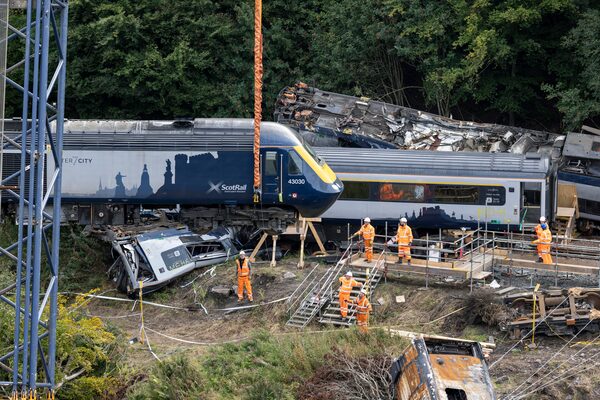
A carriage is lifted by crane from the site of the Stonehaven train derailment, on Sept. 10, 2020.Derek Ironside/The Associated Press
An investigation into a train crash in northeastern Scotland last month that killed three people has found that the train struck a pile of washed-out rock and gravel before derailing, according to an interim report released Thursday.
The driver, a conductor and a passenger died when the ScotRail train came off the tracks near the coastal town of Stonehaven on Aug. 12. The first of the derailed carriages is expected to be removed from the site on Thursday.
Investigators said “a significant contributing factor” to the derailment was heavy rainfall washing material from adjoining slopes, or earthworks, onto the tracks.
Network Rail, which is government-owned and responsible for the U.K.'s train tracks, set out plans in the report on how to reduce the risk of such landslips but acknowledged it cannot afford to strengthen all “substandard” trackside slopes.
“We are all aware that we are increasingly seeing more incidents of severe weather and, as the report published today shows, earthworks and drainage infrastructure – some of which are more than 150 years old –– prove to be a real challenge as the country experiences more heavy rainfall and flooding,” Network Rail chief executive Andrew Haines said.
Unions urged the British government, which commissioned the report, to provide the necessary investment to secure the railways for the future.
“It’s crystal clear that climate change is leading to more extreme weather events, which brings huge challenges to transport infrastructure,” said Manuel Cortes, general secretary of the Transport Salaried Staffs Association.
In the report, Network Rail said weather-related issues are likely to continue and it is “simply not economically viable to strengthen all substandard infrastructure slopes.”
Network Rail said it is working with meteorologists to understand how real-time information can improve operational responses to severe weather and it is investigating the use of technology and data to help make better decisions.
It also said it has introduced emergency changes to the way signallers should act in severe weather, following reports of increased water levels near tracks and when there are concerns about unstable ground due to heavy rain.
These include stopping all trains until lines have been inspected by a competent engineer.
The company said it has conducted 584 inspections of sites which share some of the characteristics of the location of the Stonehaven crash, including with the help of helicopter surveys. It said no significant issues “requiring emergency intervention” were found.
Our Morning Update and Evening Update newsletters are written by Globe editors, giving you a concise summary of the day’s most important headlines. Sign up today.